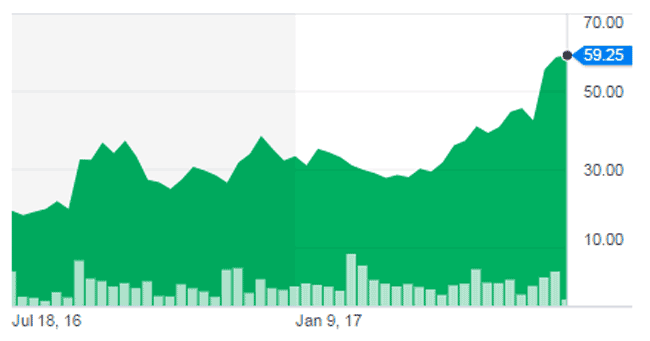Below are our selection of the top stories of the week in RFID, automatic identification technoligies, and the Internet of Things.
Did You Buy RFID-Maker Impinj Stock Last Year?
In June of 2016, an article in SCDigest asked the following question: Should You Buy Into RFID Solution Leader Impinj's New Initial Public Offering?
Impinj was founded in 2000 based on the research of Carver Mead at the California Institute of Technology and his student Chris Diorio. In 2006, Impinj became one of the first the companies to introduce products based on the EPCglobal UHF Gen 2 standard.
Supply Chain Digest Says... |
 |
| The fundamental problem is using the internet to control devices that it was never intended to control. |
 |
What do you say? |
| Click here to send us your comments |
 |
| Click here to see reader feedback |
|
|
The short answer to the question above on buying Impinj stock should have been Yes.
The company has been growing revenue rapidly, to $112 million in 2016 from $78.5 million the year before. While it fell to a $1.6 million loss last year versus a modest $900,000 profit in 2015, Wall Street is excited about the company's growth potential.
After opening at about $18 per share with its IPO last summer, the stock has mostly headed up, as shown in the chart below. After moving to over $42 per share in early June, as can be seen in the chart the stock got a big boost in recent weeks when Amazon announced its intention to acquire Whole Foods. Impinj's stock price rose to almost $60 per share, making it almost a "four bagger" since the IPO.
Why did Amazon's deal send Impinj's stock so much higher?
Both Seattle-based companies, Amazon is a member of RAIN RFID, an alliance co-founded by Impinj in 2014 to spread awareness of RFID technology. Further developing the relationship, Amazon and Impinj are co-hosting a meeting of this group in Seattle next month.
Investors are betting that Amazon may use Impinj's RFID solutions (tags, readers, software) at Whole Foods. Impinj also had a stock bump when Amazon announced its Go store concept last year, on speculation that "grab and go" approach was powered in part by RFID, though it remains unclear if that is the case.
Impinj's Stock has been Up Sharply Since Its IPO Last Summer

So all SCDigest can say is we teed Impinj up as a potential investment a year ago – alas, we didn't pull the buy trigger then either.
We Should be Very Worried about IoT Security
SCDigest has written many stories about the potential security risks from Internet of Things (IoT) technology, but here's another, more ominous than most.
(See More Below)
|
CATEGORY SPONSOR: SOFTEON |
|
|
| |
|
|
The fundamental problem is using the internet to control devices that it was never intended to control. So says Joe Weiss, a highly respected electrical engineer. Among these areas are industrial systems in power plants or factories, devices that manage the flow of electricity through the energy grid, medical devices, smart-home systems, and many more, Weiss said, in an interview for the Quartz.com web site.
The Quartz article relays a problem that occurred last year with the popular Nest IoT home thermostat system. In mid-January 2016, there was a problem with a software update from the month before. The result: a software glitch caused the devices to use up all their battery power, shutting them down and causing thousands of customers to have their heat turned off in the middle of a cold winter night.
"The Internet of Things is just a marketing term that somebody thought up long after millions of machines were already networked," Weiss told Quartz, "And most of them are networked in ways that can be accessed, perhaps indirectly, from the public internet."
Case in point: In Oct. 2016, over 100,000 video surveillance cameras connected to the internet were compromised by a hacking group, turned into a botnet, and then used to launch a distributed denial of service (DDoS) attack on one of the largest internet address lookup sites, the Domain Name System servers, taking down hundreds of major web sites for a while.
And did you know this? While many IoT devices are protected by a user-generated password, often the manufacturer writes its own password in the source code so that it can always get in if it needs to. These so-called hard coded passwords are discovered and sometimes sold on the internet black market,
And one hesitates to think of the nightmare that hacked accessed to connected medical devices, such as pacemaker, could cause, as manufacturers in that sector jump on the IoT bandwagon.
While actions are being taken to add protections, "the internet is and will remain the new Wild West for on-line criminals," Weiss fears.
The UK's Barclays Bank Working on Self-Scanning Mobile App for Groceries
With the aforementioned Amazon Go stores testing the idea of simply removing an item from the shelf triggering a charge to a customer via a smart phone app and a whole bunch of other technology, British bank Barclays is working on a smart phone app to allow customer self-scanning of groceries.
 The "Grab+Go" app basically turns a phones camera into a bar code reader, with consumers scanning items as they are placed into a cart or shopping bag. When finished a consumer checks out inside the app, with purchases charged to a linked credit card. It then generates a digital receipt that the merchant also has access to, in case they suspect a consumer is hiding unscanned items. The "Grab+Go" app basically turns a phones camera into a bar code reader, with consumers scanning items as they are placed into a cart or shopping bag. When finished a consumer checks out inside the app, with purchases charged to a linked credit card. It then generates a digital receipt that the merchant also has access to, in case they suspect a consumer is hiding unscanned items.
The "pocket checkout" concept is currently being trialed in the staff canteen at Barclays' London HQ, with further testbeds in UK and US offices going live in the near future. A retailer is expected to have a Grab+Go pilot up and running within the next year.
Barclays says it thinks the technology is not likely to be used by major grocery chains, but rather at smaller shops and smaller convenience stores, the kind of places customers pop in to for just a few items. This technology would allow them to avoid the check out line.
Will consumers be honest, especially if they have trouble scanning an item? That would seem to be the key question.
Any reaction to these news stories? Let us know your thoughts aththe Feedback button below.
Your Comments/Feedback
|